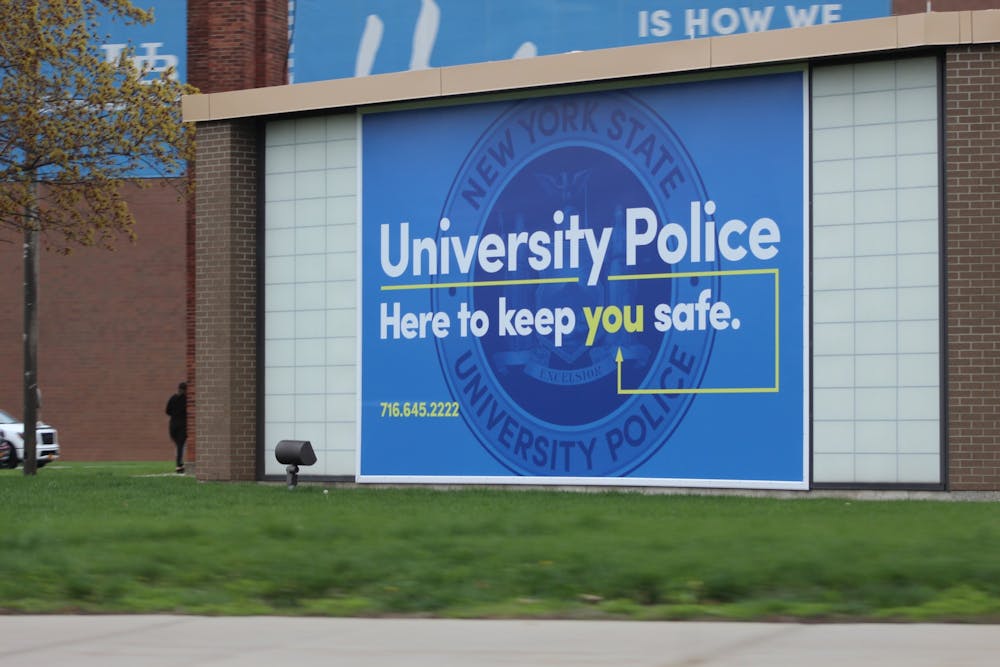On-campus crime fell in 2020, but liquor and drug violations remained the leading causes of referral, according to the 2020 Annual Security and Fire Safety Report released by University Police at the end of September.
UPD reported 281 liquor violations and 128 drug violations in 2020, down from 409 and 299, respectively, in 2019. This coincided with a decrease in the number of students living on campus, courtesy of the COVID-19 pandemic and UB’s shift to mostly online learning.
Rape cases fell from 19 to two in one year. Both rape incidents occurred on North Campus, with one taking place in the residence halls. Other sex-based crimes — like domestic violence and stalking — also fell in 2020.
Eighteen of the 25 primary crimes — defined as murder, manslaughter, rape, robbery, burglary, motor vehicle theft, dating violence and stalking, amoung others — were committed on North Campus, with the other seven occuring on South Campus. These crimes included robbery, aggravated assault, burglary and motor vehicle theft. UPD didn’t report any crimes at the school’s Downtown Campus. There haven’t been any murders on campus in at least the last five years.
Deputy Chief of University Police Joshua Sticht says the disparity in crimes between campuses and the overall decrease in crime in 2020 can be partly attributed to population and partly attributed to the pandemic.
“Since the North Campus [has] opened, there have almost always been more crimes on [North] Campus,” Sticht said. “The simple reason for this is that there are many more people on the North Campus than there are on the South Campus. More people and more buildings translates into more opportunities for crime to occur. We should also remember that for most of 2020, the only students living on the South Campus were in the quarantine site at Goodyear and Clement, a much smaller population than we normally have on the South Campus.”
Sticht says he believes UB is a safe place to study, especially when compared to some of the surrounding areas.
Buffalo — population 255,284 — recorded 141 cases of assault in October 2020, in addition to a high murder rate.
Sex-based discrimation and violent crime falls under the university’s Title IX coordinator’s office. Dating violence — of which there were three cases in 2020 — also falls under the purview of Title IX. Title IX applies to any school that accepts federal funding.
Sharon Nolan-Weiss, UB’s Title IX coordinator in the Office of Equity, Diversity and Inclusion, said in a statement to The Spectrum that she is responsible for coordinating the university’s response to sex-based crimes and that her office is able to help victims, whether or not they choose to press charges.
“[The response] may include coordinating among University Police, Student Conduct and Advocacy, or the Office of Employee Relations when someone reports sexual misconduct and is seeking redress through the criminal justice system or university conduct processes,” Nolan-Weiss said. “It’s important to note that even if the person who experienced sexual violence does not wish to pursue charges, UB can provide accommodations and support, including housing accommodations, no contact orders, academic accommodations, counseling, medical care, and advocacy services. As the Title IX office, Equity, Diversity and Inclusion can meet with anyone seeking assistance to explain the available reporting and support options, and we can reach out to faculty or staff as necessary (and with the person’s permission) in order to coordinate accommodations and support.”
The 2020 data is reported by UPD annually and is available to all current UB students and employees and members of the public upon request.
Julie Frey is the asst. news/features editor and can be reached at julie.frey@ubspectrum.com

Julie Frey is a senior news/features editor at The Spectrum. She is a political science and environmental studies double major. She enjoys theorizing about Taylor Swift, the color yellow and reading books that make her cry. She can be found on Twitter @juliannefrey.





